Some History of the Chartres Pilgrimage
The Cathedral of Chartres is the Key to Understanding the Pilgrimage to Chartres
“This has been standing here for centuries. The premier work of man perhaps in the whole Western world, and it’s without a signature: Chartres. A celebration to God’s glory and to the dignity of man. All that’s left, most artists seem to feel these days, is man. Naked, poor, forked radish. There aren’t any celebrations. Ours, the scientists keep telling us, is a universe which is disposable. You know, it might be just this one anonymous glory of all things, this rich stone forest, this epic chant, this gaiety, this grand, choiring shout of affirmation, which we choose when all our cities are dust, to stand intact, to mark where we have been, to testify to what we had it in us to accomplish.” - Orson Welles
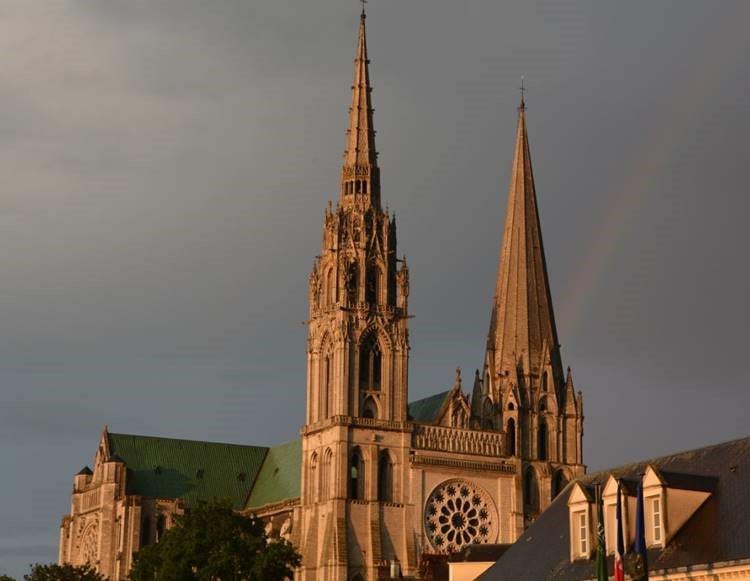
For more than a thousand years Our Lady’s cathedral at Chartres has stood in grand gothic testimony to the faith of our fathers and the Christian cult of the Blessed Virgin Mary. Before Chartres, Christian churches were typically dedicated to the saints whose relics they were built to house. Chartres is different, for it is one of the first dedicated solely to the Mother of God. She so stirred the medieval soul that nearly all cathedrals that came after Chartres were dedicated to Our Lady—Notre Dame—the Virgin Mother of God.
In a very real sense, then, the master builders of Chartres pioneered the cult of the Blessed Virgin Mary that would come to dominate Christian Europe for a millennium. And Chartres became the fourth most popular pilgrimage destination on earth because of a simple piece of silk cloth worn by a young Jewess from Nazareth when Caesar still ruled the world. Her name was Mary, and her veil is the raison d’être of Notre-Dame de Chartres. One of the most important relics of Christendom, tradition tells us that it adorned the Virgin’s head when Gabriel announced the Incarnation.
Pilgrims flocked to this relic of their Mother, aching for a connection with her; to be near and to venerate a piece of her whom they loved with the simple yet profound affection of children. The early pilgrims arrived in Chartres and immediately descended into the crypt where the veil could be venerated. They spent the night in prayer and slept on the cold stones, content just to spend the hours with her in silence. The next morning they’d head back home. Some had much farther to go than others, but all were connected in a powerful and intangible way, for the rest of their lives.
The holy relic of Chartres which they came to venerate is also the silk garment which Our Lady used to cover the Baby Jesus in Bethlehem’s cave.
According to Blessed Ann Catherine Emmerich, Mary also placed this same veil over her crucified Son's nakedness when He was taken down from the Cross. It was discovered by St. Helena, along with the True Cross, in the year 326, who presented it to her son, the Emperor Constantine. Later, the Empress Irene gave it to Charlemagne’s grandson, Charles the Bald, who donated it to Chartres in the year 876 AD and where it remained for the next 1100 years.
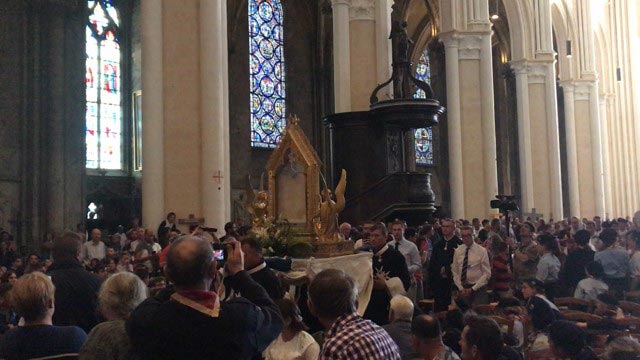
The Veil was brought through the nave of Chartres Cathedral in its splendid reliquary for the pilgrims to see during the processional in 2017, just before Cardinal Burke celebrated the Pontifical High Mass which closed out the Pentecost Pilgrimage.
With the veil’s fabric tested by scientists in modern times and its movement meticulously tracked by historians down through the ages, there can be little doubt as to its authenticity. Chartres’s crypt—the first Chartres cathedral—was expanded specifically as a reliquary for the veil of the Mother of God. But atypically, there are no graves in that crypt; no tombs, no remains of the dead.
Rather it has always been a place for the living, specially reserved for Mary to come and go as she pleased. The great gothic jewel was built by the sons of Clovis as a “play house” for their mother. And pilgrims for a thousand years have walked to Chartres to venerate the veil in which it is said that Mary wrapped the Savior of the World in Bethlehem.
Although the first cathedral was destroyed by fire in 1194, the precious veil was saved and Notre-Dame de Chartres, as it stands today, was quickly rebuilt by Catholics who literally carried their cathedral on their backs, one block at a time, from a nearby quarry, and then dedicated the rest of their lives to fashioning them into a castle fit for their heavenly queen.
Today the cathedral at Chartres stands as the greatest monument to Christian faith ever built by human hands. She has been called the “Bible of the poor” because her stained glass, sculptures, and architecture educated pilgrims for a thousand years.
From crypt to nave to contrasting spires three stories high, Chartres tells the story of salvation from the Garden of Eden to the Resurrection of Christ.
Her 150 13th-century stained-glass windows document salvation history from the dawn of time. And while Christians in medieval times may have been illiterate, they were well versed in the rich symbolism of the windows of Chartres. Like a mother teaching her children, Notre-Dame de Chartres spent centuries silently catechizing our forefathers in the Catholic Faith.
There are layers upon layers of symbolism everywhere one looks in Chartres, even in her stone floor which incorporates a labyrinth representing man's earthly journey from darkness to light. As they walk the labyrinth's path, pilgrims must make repeated changes in orientation away from Satan and towards the heavenly Jerusalem.
And the precision of the Christian architects was such that, were the facade to be lowered to the floor, Chartres’s famous North Rose window would come to rest precisely over the labyrinth.
The great twentieth-century French poet and convert to Catholicism, Charles Peguy, made a journey along the labyrinth on his knees after one of his pilgrimages to Chartres. His story is worth retelling since this agnostic poet singlehandedly revived the ancient pilgrimage to Chartres, the very one which we emulate today…
Charles Péguy (1873 – 1914)
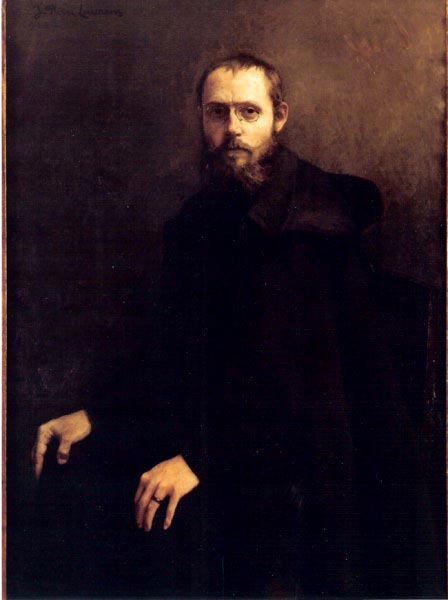
For a good part of his life Charles Péguy was an ardent socialist and an on-again, off-again agnostic. Before his death on the battlefield in the early days of World War I, he’d become a believer whose gradual conversion was met with disbelief by France’s literary community.
For Péguy, his coming to terms with the Catholic Faith was a lonely and often turbulent fight that manifested itself through some of the most soul-stirring and provocative French-language poetry of the 20th century.
Though he’d become a believer, it wasn’t until Péguy found himself on the battlefield that he resolved to fully return to the Sacraments. Nevertheless, so compelling was his written record of transformation from agnostic to believer that when word of his death reached T. S. Eliot, the great English-language poet mourned “one of the most illustrious of the dead who have fallen in this war.”
Péguy is no plaster saint. His journey into the light is not without long and extended dark nights. Even after his conversion he remained among the walking wounded of post-Revolution “enlightened” France, ever searching for a way back home. As one writer put it, “Péguy seems to have come to an understanding through his experience that pain and even a vulnerability to sinfulness often are the only ways to open channels by which real grace can reach us, particularly those of us who think our faith and morals are already enough.”
Not surprisingly, the notion of Catholic pilgrimage emerges as integral to the struggle of Charles Péguy, so much so, in fact, that this passionate and often volatile personality practically singlehandedly breathed life back into what had come to be regarded as an outmoded “medieval ritual”.
Had it not been for Péguy it is highly unlikely that the Chartres Pilgrimage would have survived the attempted purging of all things Catholic which took place in Europe from World War I to the present.
Here is what happened.
Charles Péguy’s son Marcel had fallen deathly ill and, rather than giving in to despair, Péguy placed his son in the hands of the Blessed Virgin Mary – vowing to retrace the ancient pilgrim’s path (the French starting point on the Pilgrimage to Santiago de Compostela) from Paris to Chartres when his son regained his health.
Marcel recovered, and his father was true to his word, walking to Chartres not once but several times before his death two years later. Through the process of physical pilgrimage, the warrior poet evidently sought to earn the right to lay claim to the Faith he’d once strained against.
Pious platitudes and easy creeds were not the stuff of which Charles Péguy was made. He was a soldier and a poet, but not a saint and, as such, the notion of pilgrimage appealed to his warrior heart.
Inspired by his example if baffled by his conversion, friends tracked Péguy along his newfound pilgrim’s path. And after his death, when his popularity began to increase, admirers from all walks became interested in retracing the footsteps not only of Joan of Arc and St. Louis IX, but also Charles Péguy—over the plain la Beauce, through the forests near Choisel, and into the gothic sanctuary of Notre-Dame de Chartres where Péguy had surrendered his cold rationalism at the altar of Faith.
Here the sophisticated man of letters shocked the world by humbly declaring himself “subject to the Virgin of Chartres.” And all Paris gasped!
The Chartres Pilgrimage Today: In the Footsteps of Saints and that tenacious French poet
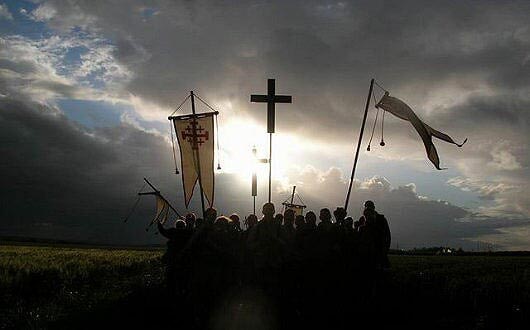
The Pilgrimage to Chartres, which is the French leg of the great “Camino” or “way” of the Pilgrimage to Santiago de Compostela, Spain, originated in the 12th century and continued each year without interruption, except perhaps during the various wars, until the time of Vatican II, after which it would have disappeared altogether were it not for a small group of traditional Catholics who revived it in 1982. Since then it has grown into a major force for Catholic revival in Europe.
I recall my old friend, Arnaud de Lassus (RIP), describing to me how it had been when he and his friends had arrived in the old city some 40 years ago, after having rejuvenated the old pilgrimage to Chartres after Vatican II. Those early post-Vatican II pilgrims were not even allowed into the Cathedral but were obliged to offer the Traditional Latin Mass outside the locked doors of Notre-Dame de Chartres.
The restoration of the Catholic Mass of the Ages, and by extension the restoration of Christendom—the Social Reign of Christ the King—became these first pilgrims’ battle cry; the very reason for which they marched year after year along the dusty road from Paris to Chartres.
I wonder if those first Chartres pilgrims ever imagined that one day high-ranking prelates such as Cardinals Raymond Burke, Castrillon Hoyos (RIP) and Robert Sarah would celebrate Solemn Pontifical High Masses—in the ancient rite, of course—not only in Chartres at the conclusion of the Pilgrimage, but also at Notre-Dame de Paris at its beginning.
I wonder if they ever could have anticipated that prominent political figures, such as Marion Jeanne Marechal-Le Pen—niece of Marine La Pen, Front National candidate who came in second in a recent race for the presidency of France—would one day be walking among the pilgrims to Chartres every year.
Standing there locked out of their own Cathedral 40 years ago, did they even dream that pilgrims from all over the world would one day travel thousands of miles to join them on the road to Chartres?
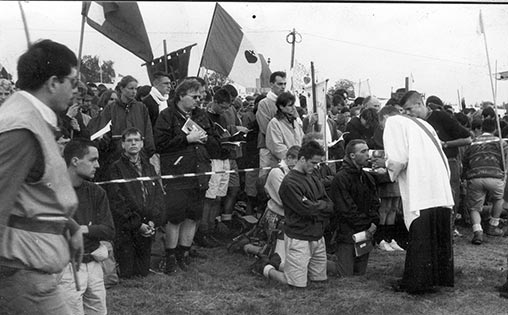
Their humble efforts would one day blossom into an international event, providing living, breathing proof of the youth and vitality of a growing Catholic restoration movement.
The pilgrims to Chartres stand on the shoulders of giants, in other words—men who refused to abandon the Faith of our Fathers.
Back in 1991, The Remnant began organizing the U.S. contingent on the Pilgrimage. Every year since, nearly one hundred Americans again have crossed the Atlantic seeking to find what Péguy had found. Like him, they sought to place themselves in the hands of the Mother of God.

Michael Davies and Michael Matt, Chartres Pilgrimage 1998
Like Péguy’s Marcel, their children are also dying, in the sense that their souls are under constant assault from those who would sooner see them dead than Catholic.
Like Péguy’s, their world is also on the brink of war, perhaps literally, but certainly morally and spiritually.
Like Péguy, the pilgrims are not saints, which is why during this worldwide offensive against marriage and the family, the unborn, the innocence of children and the Church herself—they recognize no better means of surviving the onslaught than falling to their knees before the Mother of God.
The sight of the Cathedral—after walking three days, sleeping on the ground for two nights, eating the meager pilgrim’s fare—offers promise of home. Along the road to Chartres, it’s as if the revolution in the Church never happened.
The Pilgrimage starts in Paris and concludes in Notre-Dame de Chartres on Pentecost Monday. Thousands of pilgrims pack the cathedral, and another seven thousand spill out into the square outside.
In one voice the massive assembly brings their pilgrimage to a glorious conclusion with the Chez Nous—the love song to Our Lady. And then it’s back to the front—the blisters, rocky ground, damp sleeping bags, meager soup, hard bread and endless walking having once again become the happy memories of the grand Catholic adventure that is the Pilgrimage to Chartres.
The years move along. The young French scouts who dominate the pilgrimage, were not yet born when I made my first walk to Chartres. To them I suppose, if they think of me at all, I’m the old pilgrim from America who walked to Chartres with their mothers and fathers many years ago.
But I wonder if they realize how much they mean to me—how much hope the sight of them singing or praying or playing stirs in this old American’s heart. Where did they come from? How did they survive…these beautiful Catholics with their smart-looking blue uniforms, big boots and broad, easy smiles? How is it that they were spared the all-out assault on innocence that is the purview of the modern world?
The answer is obvious: Throughout their new, little lives they’ve been walking to Chartres every Pentecost weekend. They go there to find their Mother, to sing for her and to blithely place themselves under her protection. Chartres is her playhouse, and these are the children with whom she plays—the children she makes her own. They belong to her, safe and protected beneath her veil.
Maybe that’s why we all go back Chartres each year—to be with her, to become Mary’s children again, who trust and hope in her so intuitively and so completely that she can’t refuse to make us her own. At Chartres, Mary makes us hers again, and on this side of heaven’s gate there is no greater feeling than that.
Nearly 20,000 Catholic pilgrims walk to Chartres on Pentecost Monday every year. The procession into the Cathedral includes hundreds of traditionalist priests, monks and abbots, along with the Bishop of Chartres.
The Mass of Ages fills the cathedral with all the glory for which she was meant, and the stones themselves seem to assist the pilgrims in their triumphant praise of God and of His mother. This is the moment for which they’ve trudged three days in the rain or the harsh sun; this is why they’ve slept on the ground beneath the stars and lived on bread and water… It’s the same moment for which the pilgrims of the 12th century traveled even greater distances. The same Faith, the same love that drives them forward; the same Mother who calls them home.
How does one describe such a tangible connection with Christians a thousand years dead—men and women who would have leaned against this same pillar, touched that same stone, knelt before the same veil, and made silent appeal to the same Virgin Mother?
It can’t be described. We’ve reached the limit of the written word, my friends. Chartres Cathedral and its Pilgrimage must be experienced to be believed.
Join us and find out for yourselves. You’ll never be the same after making the Pilgrimage to Chartres. After that you will discover what we’ve lost but what we can regain if we have the courage, the love, the faith and the hope to become pilgrims and to stay pilgrims for the rest of our lives—pilgrims united in love for Our Lady of Christendom, Our Lady of Chartres, the Mother of God and Mother to us all.
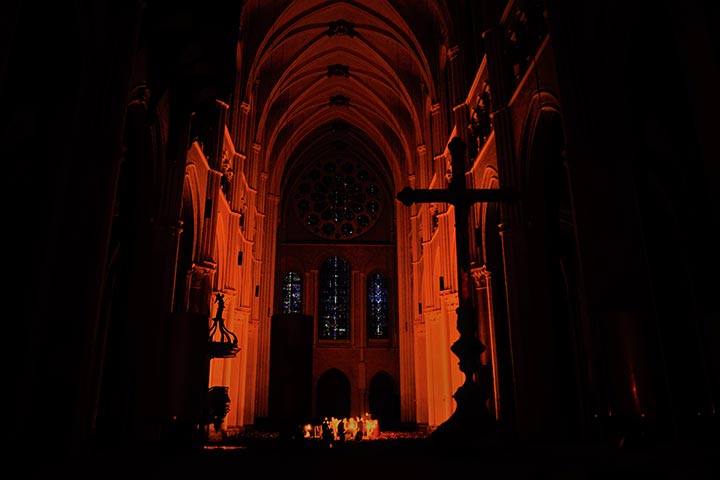
For the past two years Remnant Tours has arranged a candlelight procession at midnight through the crypt of Chartres Cathedral and up into the nave, where the little group of Americans sings hymns to Our Lady which the pilgrims of Christendom would have sung, and see Chartres in a way that very few since those early pilgrims have seen her… This is peace on earth, and a glimpse of heaven.